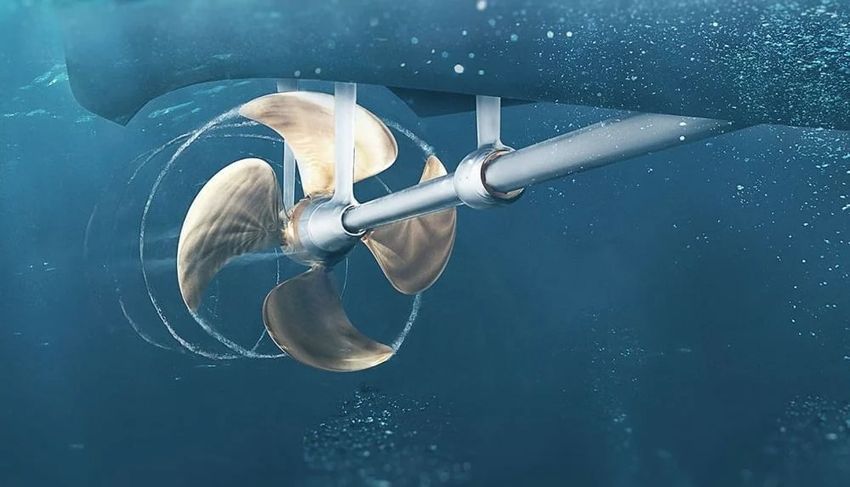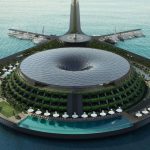Introduction
Ever wondered what propels massive ships across oceans or how submarines glide silently beneath the waves? The secret lies in marine propulsion systems—the engines and technologies that power vessels worldwide. From the steam engines of the Industrial Revolution to today’s nuclear-powered submarines, the evolution of marine propulsion has revolutionized global trade, transportation, and defense. In this article, we’ll explore how marine propulsion systems work, their fascinating history, and the cutting-edge innovations shaping the future of maritime travel. 🌊🚢⚡
🧠 What Is a Marine Propulsion System?
A marine propulsion system is the machinery and technology used to generate thrust and propel a ship through water. These systems convert various energy sources—like steam, diesel, electricity, or nuclear power—into mechanical motion that drives propellers, water jets, or other propulsion devices.
Key Components Include:
- Engine: Converts energy into mechanical power (e.g., steam engine, diesel engine, or nuclear reactor)
- Propeller or Water Jet: Transfers engine power into thrust, pushing the ship forward
- Transmission System: Transfers power from the engine to the propeller shaft
- Control Systems: Regulate engine speed, direction, and efficiency
⚓ The Evolution of Marine Propulsion: A Journey Through Time
🚂 1. Steam Propulsion (Early 19th Century)
- Invention: Steam engines revolutionized maritime travel, replacing wind-powered sails with reliable mechanical power.
- How It Works:
- Water is heated in a boiler to create steam.
- High-pressure steam drives pistons or turbines, converting thermal energy into mechanical motion.
- The pistons or turbines rotate a propeller shaft, propelling the ship forward.
Fun Analogy: Imagine blowing up a balloon and releasing it—the escaping air pushes the balloon forward, just like steam pushes a ship’s pistons! 🎈💨🚢
Famous Example:
- SS Great Eastern (1858): One of the largest steamships of its time, designed by Isambard Kingdom Brunel.
Advantages:
✅ Reliable and powerful
✅ Enabled faster, more predictable travel
✅ Revolutionized global trade and transportation
Disadvantages:
⚠️ Consumed large amounts of coal
⚠️ Heavy and bulky machinery
⚠️ Limited speed and efficiency
⚙️ 2. Diesel Propulsion (Early 20th Century)
- Invention: The development of internal combustion engines transformed marine propulsion, offering greater efficiency and power.
- How It Works:
- Diesel fuel is injected into a combustion chamber and ignited by high pressure.
- The resulting explosion drives pistons, which turn a crankshaft connected to the propeller.
Fun Analogy: Think of a car engine—only much larger and built to power ships instead of cars! 🚗💥🚢
Famous Example:
- RMS Titanic (1912): Although primarily steam-powered, Titanic also used diesel generators for electricity.
Advantages:
✅ More fuel-efficient than steam engines
✅ Smaller and lighter, saving space and weight
✅ Easier to maintain and operate
Disadvantages:
⚠️ Emits greenhouse gases and pollutants
⚠️ Dependent on fossil fuels
⚠️ Noisy and less environmentally friendly
⚡ 3. Gas Turbine Propulsion (Mid-20th Century)
- Invention: Adapted from aircraft jet engines, gas turbines provided faster and more efficient propulsion.
- How It Works:
- Air is compressed and mixed with fuel, then ignited to produce high-temperature, high-pressure gases.
- The expanding gases spin a turbine, which drives the ship’s propeller or water jet.
Fun Analogy: Imagine blowing through a pinwheel—the faster you blow, the faster it spins! 🌬️🎡🚢
Famous Example:
- USS Spruance (1975): The first US Navy ship powered entirely by gas turbines.
Advantages:
✅ Lightweight and compact
✅ High speed and quick acceleration
✅ Lower maintenance compared to diesel engines
Disadvantages:
⚠️ Higher fuel consumption at low speeds
⚠️ More expensive to operate
⚠️ Less efficient for long-distance travel
🔋 4. Electric Propulsion (Mid-20th Century to Present)
- Invention: Electric propulsion systems combine traditional engines with electric motors, offering greater efficiency and flexibility.
- How It Works:
- A diesel engine, gas turbine, or nuclear reactor generates electricity.
- The electricity powers electric motors that drive the propeller, reducing mechanical complexity.
Fun Analogy: Think of an electric car—quiet, efficient, and environmentally friendly! 🚗⚡🚢
Famous Example:
- Queen Mary 2 (2003): The world’s largest ocean liner uses electric propulsion for smooth, efficient travel.
Advantages:
✅ Quiet and vibration-free operation
✅ Improved fuel efficiency and emissions control
✅ Flexible power generation and distribution
Disadvantages:
⚠️ Higher upfront cost
⚠️ Requires advanced electrical systems and maintenance
☢️ 5. Nuclear Propulsion (Mid-20th Century to Present)
- Invention: Nuclear reactors provide immense power for military ships and submarines, enabling extended missions without refueling.
- How It Works:
- Nuclear fission releases heat, which converts water into steam.
- The steam drives turbines that generate electricity and power the ship’s propulsion system.
Fun Analogy: Imagine a kettle boiling continuously, with the steam turning a wheel that propels the ship! ♨️🚢
Famous Examples:
- USS Nautilus (1954): The world’s first nuclear-powered submarine
- USS Enterprise (1961): The first nuclear-powered aircraft carrier
Advantages:
✅ Unlimited range without refueling
✅ High power output for large ships and submarines
✅ Reduced reliance on fossil fuels
Disadvantages:
⚠️ High construction and maintenance costs
⚠️ Strict safety and environmental regulations
⚠️ Complex operation requiring trained personnel
💡 How Propellers and Water Jets Generate Thrust
🚀 Propellers:
- Propellers work like airplane wings, creating lift that pushes the ship forward.
- Each blade is shaped like an airfoil, generating pressure differences that produce thrust.
🌊 Water Jets:
- Water jets suck in water, accelerate it through a pump, and expel it at high speed, propelling the ship forward.
- Common in high-speed vessels like ferries, patrol boats, and jet skis.
Fun Analogy: Think of a garden hose—when you squeeze the nozzle, the water shoots out faster, pushing the hose backward! 💦🚤
🧩 Comparison of Marine Propulsion Systems
| Propulsion System | Energy Source | Speed | Efficiency | Common Uses |
|---|---|---|---|---|
| 🚂 Steam Propulsion | Coal or oil | Moderate | Low | Historical ships, early ocean liners |
| 🛢️ Diesel Propulsion | Diesel fuel | Moderate | High | Cargo ships, cruise ships, naval vessels |
| 🛫 Gas Turbine | Jet fuel or natural gas | High | Medium | Warships, fast ferries, high-speed vessels |
| ⚡ Electric Propulsion | Diesel, gas, or nuclear | Moderate | Very high | Cruise ships, ferries, research vessels |
| ☢️ Nuclear Propulsion | Nuclear fission | High | Very high | Submarines, aircraft carriers, icebreakers |
🌍 Modern Innovations in Marine Propulsion
-
Hybrid Propulsion Systems:
- Combine diesel, electric, and battery power for greater efficiency and reduced emissions.
- Example: Hybrid ferries and luxury yachts that switch to electric mode in eco-sensitive areas.
-
LNG (Liquefied Natural Gas) Propulsion:
- Cleaner and more efficient than diesel, reducing greenhouse gas emissions.
- Example: LNG-powered cargo ships and cruise liners.
-
Battery-Powered Ships:
- Fully electric ships use rechargeable batteries, producing zero emissions.
- Example: Electric ferries in Norway and Denmark, promoting sustainable transportation.
-
Autonomous Ships:
- AI-powered ships navigate and operate without human crews, reducing costs and improving safety.
- Example: The Mayflower Autonomous Ship (MAS), an AI-powered research vessel.
-
Hydrogen Fuel Cells:
- Hydrogen fuel cells generate electricity through a chemical reaction, emitting only water vapor.
- Example: Zero-emission ferries and cargo ships powered by hydrogen fuel cells.
🌱 Sustainability and the Future of Marine Propulsion
As the shipping industry faces pressure to reduce carbon emissions, the future of marine propulsion is focused on:
- Renewable Energy: Using solar, wind, and hydrogen power for zero-emission shipping.
- Energy Efficiency: Improving engine designs and optimizing ship hulls to reduce fuel consumption.
- Emission Reductions: Switching from diesel to LNG, biofuels, and electric propulsion to meet global climate targets.
- Eco-Friendly Ports: Developing green port infrastructure with shore power and charging stations for electric ships.
Goal: By 2050, the International Maritime Organization (IMO) aims to reduce greenhouse gas emissions from shipping by at least 50%. 🌱🌍🚢
🛡️ Safety and Challenges of Marine Propulsion Systems
- Steam Engines: Risk of boiler explosions and overheating.
- Diesel Engines: Emissions of greenhouse gases and air pollutants.
- Gas Turbines: High fuel consumption at low speeds.
- Electric Propulsion: Limited by battery capacity and charging infrastructure.
- Nuclear Propulsion: Safety concerns, radiation risks, and complex regulations.
🔮 The Future of Marine Propulsion
The future of marine propulsion is focused on sustainability, efficiency, and automation:
- 🚢 Fully Electric Cargo Ships: Zero-emission shipping with advanced batteries and renewable energy.
- 🌊 Hydrogen-Powered Ships: Clean and efficient, with only water as a byproduct.
- 🌱 Wind-Assisted Propulsion: Modern sails and wind turbines reduce fuel consumption.
- 🤖 AI and Automation: Smart navigation systems improve efficiency and safety.
- 🔋 Advanced Batteries: Longer-lasting, faster-charging batteries for electric ships.
📝 Conclusion
From the steam engines of the Industrial Revolution to today’s nuclear-powered submarines and electric ferries, marine propulsion systems have come a long way. Each innovation has made ships faster, more efficient, and more environmentally friendly. As we look to the future, sustainable technologies like electric propulsion, hydrogen fuel cells, and autonomous ships will revolutionize maritime transportation, reducing emissions and protecting our oceans. So whether you’re sailing across the ocean or exploring beneath the waves, remember the incredible science and engineering that powers every journey! 🌊🚢⚡😊


